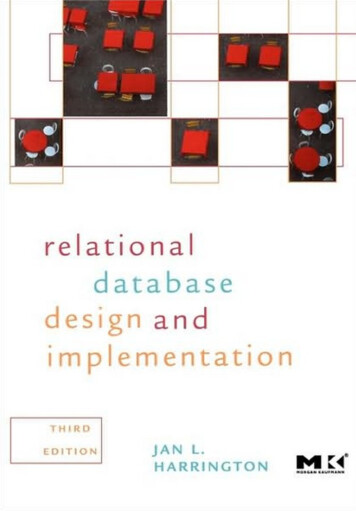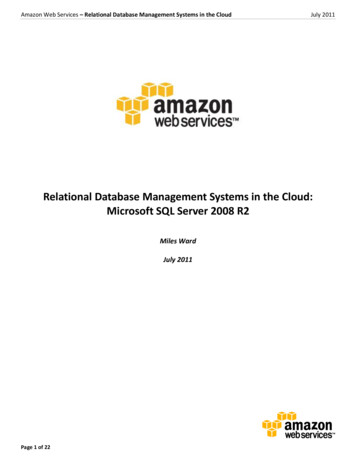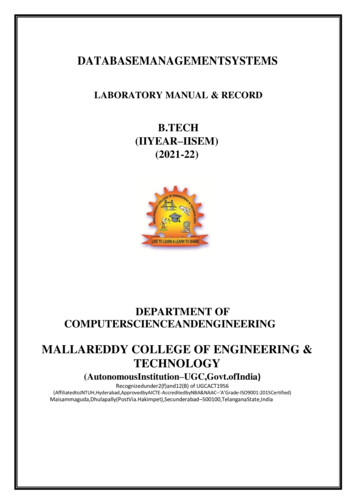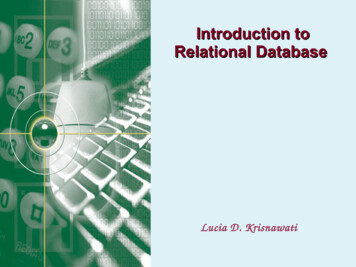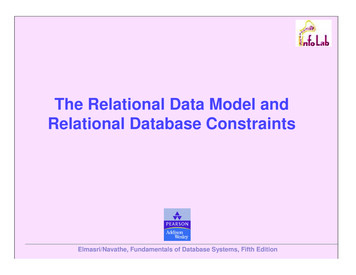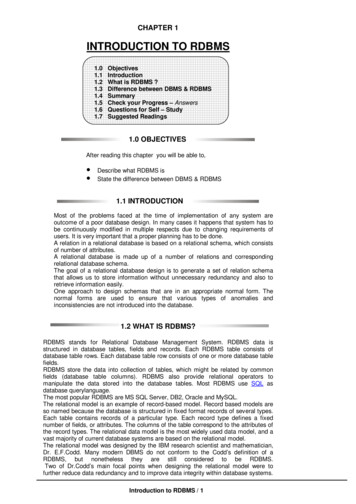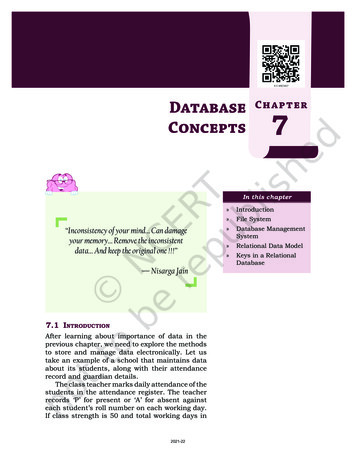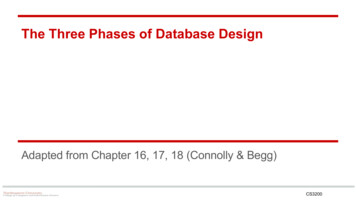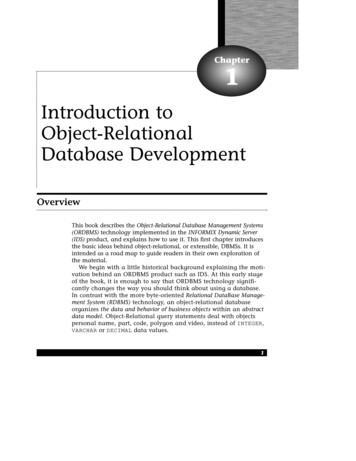
Transcription
Chapter1Introduction toObject-RelationalDatabase DevelopmentOverviewThis book describes the Object-Relational Database Management Systems(ORDBMS) technology implemented in the INFORMIX Dynamic Server(IDS) product, and explains how to use it. This first chapter introducesthe basic ideas behind object-relational, or extensible, DBMSs. It isintended as a road map to guide readers in their own exploration ofthe material.We begin with a little historical background explaining the motivation behind an ORDBMS product such as IDS. At this early stageof the book, it is enough to say that ORDBMS technology significantly changes the way you should think about using a database.In contrast with the more byte-oriented Relational DataBase Management System (RDBMS) technology, an object-relational databaseorganizes the data and behavior of business objects within an abstractdata model. Object-Relational query statements deal with objectspersonal name, part, code, polygon and video, instead of INTEGER,VARCHAR or DECIMAL data values.1
The chapter continues with a high-level description of the featuresand functionality of IDS. We introduce the Object-Relational (OR) datamodel, type and function extensibility, storage manager extensibility,and active database features. Later chapters of the book address eachtopic in more detail.Moving along, we take a little time to examine how an ORDBMS isimplemented internally. This digression is important because it providesa framework for understanding the best way to use the technology. AnORDBMS is a lot like an operating system. It manages resources such asmemory, I/O, thread scheduling, and interprocess communications.Developers can acquire these resources from the ORDBMS for their ownprograms, which run under the control of the ORDBMS (instead of theoperating system). Where the ORDBMS differs from a traditional operating system is in how it reorganizes its programs. Instead of runningbusiness logic, an ORDBMS executes it as part of a declarative queryexpressionWe conclude this chapter with a brief description of the Movies-R-Uswebsite—a sample database application—which provides many of thisbook’s examples.Evolution of Database Management SystemsThe history of DataBase Management Systems (DBMS) is an evolutionaryhistory. Each successive wave of innovation can be seen as a responseeither to some limiting aspect of the technology preceding it or todemands from new application domains. In economic terms, successfulinformation technology lowers the costs incurred when implementing asolution to a particular problem. Lowering development costs increasesthe range of information management problems that can be dealt within a cost-effective way, leading to new waves of systems development.Data ProcessingDataManagementUser-InterfaceFigure 1–1. Functional Decomposition of an Information System2Chapter One Introduction to Object-Relational Database Development
As an example of changing development costs, consider that earlymainframe information systems became popular because they couldmake numerical calculations with unprecedented speed and accuracy(by the standards of the time). This had a major impact on how businesses managed financial assets and how engineering projects wereundertaken.It took another evolutionary step—the invention of higher level languages such as COBOL—to get to the point that the economic returnfrom a production management system justified the development cost.It took still another innovation—the adoption of relational DBMSs—before customer management and human resource systems could beautomated.Today it is difficult to imagine how you could use COBOL and ISAM tobuild the number and variety of e-commerce Web sites that have sprungup over the last three years. And looking ahead, as we move into an eraof ubiquitous, mobile computers and the growing importance of digitalmedia, it is difficult to see how RDBMS technology can cope.Early Information SystemsPioneering information systems of the late 1960s and early 1970s wereconstrained by the capacity of the computers on which they ran. Hardware was relatively expensive, and by today’s standards, quite limited.Consequently, considerable human effort was devoted to optimizingprogramming code. Diverting effort from functionality to efficiencyconstrained the ambition of early developers, but the diversion ofeffort was necessary because it was the only way to develop an information system that ran with adequate performance.Information systems of this era were implemented as monolithic programs combining user-interface, data processing logic, and data management operations into a single executable on a single machine. Suchprograms intermingled low-level descriptions of data structure details—how records were laid out on disk, how records were interrelated—withuser-interface management code. User-interface management codewould dictate, for example, where an element from a disk record wenton the screen. Maintaining and evolving these systems, even to perform tasks as simple as adding new data fields and indexes, requiredprogrammers to make changes involving most aspects of the system.Experience has shown that development is the least expensive stageof an information system’s life cycle. Programming and debuggingtake time and money, but by far the largest percentage of the total costof an information system is incurred after it goes into production. Asthe business environment changes, there is considerable pressure toEvolution of Database Management Systems3
change systems with it. Changing a pre-relational information system,either to fix bugs or to make enhancements, is extremely difficult. Yet,there is always considerable pressure to do so. In addition, hardwareconstantly gets faster and cheaper.A second problem with these early systems is that as their complexity increased, it became increasingly important to detect errors in thedesign stage. The most pervasive design problem was redundancy,which occurs when storage structure designs record an item of information twice.Relational DataBase Management SystemsIn 1970 an IBM researcher named Ted Codd wrote a paper that describeda new approach to the management of “large shared data banks.” In hispaper Codd identifies two objectives for managing shared data. The firstof these is data independence, which dictates that applications using adatabase be maintained independent of the physical details by whichthe database organizes itself. Second, he describes a series of rules toensure that the shared data is consistent by eliminating any redundancyin the database’s design.Codd’s paper deliberately ignores any consideration of how his modelmight be implemented. He was attempting to define an abstraction ofthe problem of information management: a general framework forthinking about and working with information.The Relational Model Codd described had three parts: a data model,a means of expressing operations in a high-level language, and a setof design principles that ensured the elimination of certain kinds ofredundant data problems. Codd’s relational model views data as beingstored in tables containing a variable number of rows (or records), eachof which has a fixed number of columns. Something like a telephonedirectory or a registry of births, deaths, and marriages, is a good analogy for a table. Each entry contains different information but is identical in its form to all other entries of the same kind.The relational model also describes a number of logical operationsthat could be performed over the data. These operations included ameans of getting a subset of rows (all names in the telephone directorywith the surname “Brown”), a subset of columns (just the name andnumber), or data from a combination of tables (a person who is married to a person with a particular phone number).By borrowing mathematical techniques from predicate logic, Coddwas able to derive a series of design principles that could be used to guarantee that the database’s structure was free of the kinds of redundancy so4Chapter One Introduction to Object-Relational Database Development
problematic in other systems. Greatly expanded by later writers, theseideas formed the basis of the theory of normal forms. Properly applied,the system of normal form rules can ensure that the database’s logicaldesign is free of redundancy and, therefore, any possibility of anomaliesin the data.Relational Database ImplementationDuring the early 1970s, several parallel research projects set out to implement a working RDBMS. This turned out to be very hard. It wasn’t untilthe late 1980s that RDBMS products worked acceptably in the kinds ofhigh-end, online transactions processing applications served so well byearlier technologies.Despite the technical shortcomings RDBMS technology exploded inpopularity because even the earliest products made it cheaper, quicker,and easier to build information systems. For an increasing number ofapplications, economics favored spending more on hardware and lesson people. RDBMS technology made it possible to develop informationsystems that, while desirable from a business management point ofview, had been deemed too expensive.To emphasize the difference between the relational and pre-relationalapproaches, a four hundred line C program can be replaced by theSQL-92 expression in Listing 1–1.CREATE TABLE Employees essVARCHAR(128));Listing 1–1. Simple SQL-92 Translation of the Previous C CodeThe code in Listing 1–1 implements considerably more functionalitythan a C program because RDBMSs provide transactional guaranteesfor data changes. They automatically employ locking, logging, andbackup and recovery facilities to guarantee the integrity of the datathey store. Also, RDBMSs provide elaborate security features. Differenttables in the same database can be made accessible only by differentgroups of users. All of this built-in functionality means that developersfocus more of their effort on their system’s functionality and less oncomplex technical details.Evolution of Database Management Systems5
With today’s RDBMSs, the simple Employees table we introduced inListing 1–1 is more usually defined as shown in Listing 1–2.CREATE TABLE Employees (FirstNameVARCHAR(32) NOT NULL,SurnameVARCHAR(64) NOT NULL,DOBDATENOT NULL,SalaryDECIMAL(10,2) NOT NULLCHECK ( Salary 0.0 ),Address 1VARCHAR(64) NOT NULL,Address 2VARCHAR(64) NOT NULL,CityVARCHAR(48) NOT NULL,StateCHAR(2)NOT NULL,ZipCodeINTEGERNOT NULL,PRIMARY KEY ( Surname, FirstName, DOB ));Listing 1–2. Regular SQL-92 Version of the Employees TableToday the global market for RDBMS software, services, and applications that use relational databases exceeds 50 billion annually. SQL-92databases remain a simple, familiar, and flexible model for managingmost kinds of business data. The engineering inside modern relationaldatabase systems enables them to achieve acceptable performance levels in terms of both data throughput and query response times over verylarge amounts of information.Problems with RDBMSsStarting in the late 1980s, several deficiencies in relational DBMSproducts began receiving a lot of attention. The first deficiency isthat the dominant relational language, SQL-92, is limiting in severalimportant respects. For instance, SQL-92 supports a restricted set ofbuilt-in types that accommodate only numbers and strings, butmany database applications began to include deal with complexobjects such as geographic points, text, and digital signal data.A related problem concerns how this data is used. Conceptually simple questions involving complex data structures turn into lengthySQL-92 queries.The second deficiency is that the relational model suffers from certain structural shortcomings. Relational tables are flat and do not provide good support for nested structures, such as sets and arrays. Also,certain kinds of relationships, such as subtyping, between database6Chapter One Introduction to Object-Relational Database Development
objects are hard to represent in the model. (Subtyping occurs when wesay that one kind of thing, such as a SalesPerson, is a subtype ofanother kid of thing, such as an Employee.) SQL-92 supports onlyindependent tables of rows and columns.The third deficiency is that RDBMS technology did not takeadvantage of object-oriented (OO) approaches to software engineering which have gained widespread acceptance in industry. OO techniques reduce development costs and improve information systemquality by adopting an object-centric view of software development.This involves integrating the data and behavior of a real-worldentity into a single software module or component. A complex datastructure or algorithmically sophisticated operation can be hiddenbehind a set of interfaces. This allows another programmer to makeuse of the complex functionality without having to understand howit is implemented.The relational model did a pretty good job handling most information management problems. But for an emerging class of problemsRDBMS technology could be improved upon.Object-Oriented DBMSObject-Oriented Database Management Systems (OODBMS) are an extensionof OO programming language techniques into the field of persistent datamanagement. For many applications, the performance, flexibility, anddevelopment cost of OODBMSs are significantly better than RDBMSs orORDBMSs. The chief advantage of OODBMSs lies in the way they canachieve a tighter integration between OO languages and the DBMS.Indeed, the main standards body for OODBMSs, the Object DatabaseManagement Group (ODMG) defines an OODBMS as a system that integrates database capabilities with object-oriented programming languagecapabilities.The idea behind this is that so far as an application developer isconcerned, it would be useful to ignore not only questions of how anobject is implemented behind its interface, but also how it is storedand retrieved. All developers have to do is implement their application using their favorite OO programming language, such as C ,Smalltalk, or Java, and the OODBMS takes care of data caching, concurrency control, and disk storage.In addition to this seamless integration, OODBMSs possess a number of interesting and useful features derived mainly from the objectmodel. In order to solve the finite type system problem that constrainsSQL-92, most OODBMSs feature an extensible type system. Using thistechnique, an OODBMS can take the complex objects that are part ofEvolution of Database Management Systems7
the application and store them directly. An OODBMS can be used toinvoke methods on these objects, either through a direct call to theobject or through a query interface. And finally, many of the structuraldeficiencies in SQL-92 are overcome by the use of OO ideas such asinheritance and allowing sets and arrays.OODBMS products saw a surge of academic and commercial interestin the early 1990s, and today the annual global market for OODBMSproducts runs at about 50 million per year. In many applicationdomains, most notably computer-aided design or manufacturing(CAD/CAM), the expense of building a monolithic system to manageboth database and application is balanced by the kinds of performance such systems deliver.Problems with OODBMSRegrettably, much of the considerable energy of the OODBMS community has been expended relearning the lessons of twenty years ago.First, OODBMS vendors have rediscovered the difficulties of tyingdatabase design too closely to application design. Maintaining andevolving an OODBMS-based information system is an arduous undertaking. Second, they relearned that declarative languages such asSQL-92 bring such tremendous productivity gains that organizationswill pay for the additional computational resources they require. Youcan always buy hardware, but not time. Third, they re-discovered thefact that a lack of a standard data model leads to design errors andinconsistencies.In spite of these shortcomings OODBMS technology provides effective solutions to a range of data management problems. Many ideaspioneered by OODBMSs have proven themselves to be very useful andare also found in ORDBMSs. Object-relational systems include featuressuch as complex object extensibility, encapsulation, inheritance, andbetter interfaces to OO languages.Object-Relational DBMSORDBMSs synthesize the features of RDBMSs with the best ideas ofOODBMSs. Although ORDBMSs reuse the relational model as SQL interprets it,the OR data model is opened up in novel ways. New data types andfunctions can be implemented using general-purpose languagessuch as C and Java. In other words, ORDBMSs allow developers toembed new classes of data objects into the relational data modelabstraction.8Chapter One Introduction to Object-Relational Database Development
ORDBMS schema have additional features not present in RDBMSschema. Several OO structural features such as inheritance andpolymorphism are part of the OR data model. ORDBMSs adopt the RDBMS query-centric approach to data management. All data access in an ORDBMS is handled with declarative SQLstatements. There is no procedural, or object-at-a-time, navigationalinterface. ORDBMSs persist with the idea of a data language that is fundamentally declarative, and therefore mismatched with procedural OOhost languages. This significantly affects the internal design of theORDBMS engine, and it has profound implications for the interfacesdevelopers use to access the database. From a systems architecture point of view, ORDBMSs are implementedas a central server program rather than as a distributed data architectures typical in OODBMS products. However, ORDBMSs extend thefunctionality of DBMS products significantly, and an information system using an ORDBMS can be deployed over multiple machines.To see what this looks such as, consider again the Employees example. Using an ORDBMS, you would represent this data as shown inListing 1–3.CREATE TABLE Employees ssStreetAddressNOTPRIMARY KEY ( Name,);NULL,NULL,NULL,NULLDOB )Listing 1–3. Object-Relational Version of Employees TableFor readers familiar with relational databases, this CREATE TABLEstatement should be reassuringly familiar. An object-relational table isstructurally very similar to its relational counterpart and the same dataintegrity and physical organization rules can be enforced over it. Thedifference between object-relational and relational tables can be seen inthe section stipulating column types. In the object-relational table,readers familiar with RDBMSs should recognize the DATE type, but theother column types are completely new. From an object-oriented pointof view, these types correspond to class names, which are software modules that encapsulate state and (as we shall see) behavior.As another example of the ORDBMS data model’s new functionality,consider a company supplying skilled temporary workers at shortnotice. Such a company would need to record each employee’sresumes, the geographic location where they live, and a set of Periods(fixed intervals in the time line) during which they are available, inEvolution of Database Management Systems9
addition to the regular employee information. Listing 1–4 illustrateshow this is done.CREATE TABLE Temporary Employees (ResumeDOCUMENTNOT NULL,LivesAtGEOPOINTNOT NULL,BookedSET( Period NOT NULL )) UNDER Employees;Listing 1–4. Object-Relational Version of the Temporary Employees Table 1Readers familiar with earlier RDBMS releases of Informix DynamicServer (IDS) will also be struck by the use of the UNDER keyword.UNDER signifies that the Temporary Employees table inherits from theEmployees table. All the columns in the Employee table are also in theTemporary Employees table, and the rows in the Temporary Employeestable can be accessed through the Employee table.Answering business questions about temporary employees requiresthat the information system be able to support concepts such as “IsPoint in Circle,” “Is Word in Document,” and “Is some Period Availablegiven some set of Booked Periods.” In the IDS product such behaviorsare added to the query language. In Listing 1–5, we present a querydemonstrating OR-SQL.“Show me the names of Temporary Employees living within 60 miles of thecoordinates (-122.514, 37.221), whose resumes include references to bothINFORMIX and ‘database administrator,’ and who are not booked for theperiod between today and seven days ahead.”SELECT Print(E.Name)FROM Temporary Employees EWHERE Contains (GeoCircle('(-122.514, 37.221)','60 miles')),E.LivesAt )AND DocContains ( E.Resume,'INFORMIX and Database Administrator')AND NOT IsBooked ( Period(TODAY, TODAY 7),E.Booked );Listing 1–5. Object-Relational Query against the Employees Table110Note that this is illegal syntax. This figure is intended to illustrate a data modeling principle, rather than to demonstrate a use of OR-SQL. Refer to Chapter 2for more details.Chapter One Introduction to Object-Relational Database Development
Again, many readers will be familiar with the general form of thisSELECT statement. But this query contains no expressions that aredefined in the SQL-92 language standard. In addition to accommodating new data structures, an ORDBMS can integrate logic implementing the behavior associated with the objects. Each expression, orfunction name, in this query corresponds to a behaviorial interfacedefined for one of the object classes mentioned in the table’s creation.Developing an object-relational database means integrating whateverthe application needs into the ORDBMS.The examples in Listings 1–5 and 1–6 are both obvious extensions ofSQL. But an ORDBMS is extensible in other ways too. Tables in an objectrelational database can be more than data storage structures. They canbe active interfaces to external data or functionality. This allows you, forexample, to integrate software that interfaces with a paging systemdirectly into the ORDBMS, and use it as shown in Listing 1–6.“Send a page to all Temporary Employees living within 60 miles of the coordinates (-122.514, 37.221), whose resumes includes references to bothINFORMIX and ‘database administrator,’ and who are not booked for theperiod between today and seven days ahead.”INSERT INTO SendPage( Pager Number, Pass Code, Message )SELECT E.Pager Number,E.Pass Code,Print(E.Name) ': Call 1-800-TEMPS-R-US for immediate INFORMIX DBAjob'FROM Temporary Employees EWHERE Contains (GeoCircle('(-122.514, 37.221)','60 miles')),E.LivesAt )AND DocContains ( E.Resume,'INFORMIX and DatabaseAdministrator')AND NOT IsBooked ( Period(TODAY, TODAY 7),E.Booked );Listing 1–6. Object-Relational Query Illustrating External Systems IntegrationIn a SQL-92 DBMS, SendPage could be only a table. The effect ofthis query would then be to insert some rows into the SendPage table.However, in an ORDBMS, SendPage might actually be an active table,which is an interface to the communications system used to send elec-Evolution of Database Management Systems11
tronic messages. The effect of this query would then be to communicate with the matching temporary workers!Object-Relational DBMS ApplicationsExtensible databases provide a significant boost for developers building traditional business data processing applications. By implementinga database that constitutes a better model of the application’s problemdomain the information system can be made to provide more flexibility and functionality at lower development cost. Business questionssuch as the one in Listing 1–6 might be answered in systems using anSQL-92 and C. Doing so, however, involves a more complex implementation and requires considerably more effort.The more important effect of the technology is that it makes it possible to build information systems to address data management problems usually considered to be too difficult. In Table 1–1, we present alist of applications that early adopters of ORDBMS technology havebuilt successfully. Other technology changes are accelerating demandfor these kinds of systems.One way to characterize applications in which an object-relationalDBMS is the best platform is to focus on the kind of data involved. Forthirty years, software engineers have used the term “data entry” todescribe the process by which information enters the system. Humanusers enter data using a keyboard. Today many information systemsemploy electronics to capture information. Video cameras, environmental sensors, and specialized monitoring equipment record data inrich media systems, industrial routing applications, and medicalimaging systems. Object-relational DBMS technology excels at thiskind of application.It would be a mistake to say that ORDBMSs are only good for digitalcontent applications. As we shall see in this book OR techniques provideconsiderable advantages over more low-level RDBMS approaches evenin traditional business data processing applications. But as other technology changes move us towards applications in which data is recordedrather than entered, ORDBMSs will become increasingly necessary.ORDBMS Concepts and TerminologyIn this section, we introduce some of the terminology used to describeextensible database technology. For reference purposes, this book also12Chapter One Introduction to Object-Relational Database Development
Table 1–1. Extensible Database Problem DomainsApplication DomainDescriptionComplex data analysisYou can integrate sophisticated statistical and special purposeanalytic algorithms into the ORDBMS and use them inknowledge discovery or data mining applications. For example,it is possible to answer questions such as “Which attribute ofmy potential customers indicates most strongly that they willspend money with me?”Text and documentsSimple cases, such as Listing 1–5, permit you to find alldocuments that include some word or phrase. More complexuses would include creating a network that reflected similaritybetween documents.Digital asset management The ORDBMS can manage digital media such as video, audio,and still images. In this context, manage means more thanstore and retrieve. It also means “convert format,” “detect scenechanges in video and extract first frame from new scene,” andeven “What MP3 audio tracks do I have that include thissound?”Geographic dataFor traditional applications, this might involve “Show me thelat/long coordinates corresponding to this street address.” Thismight be extended to answer requests such as “Show me allhouse and contents policy holders within a quarter mile of atidal water body.” For next-generation applications, with a GPSdevice integrated with a cellular phone, it might even be able toanswer the perpetual puzzler “Car 54, where are you?”Bio-medicalModern medicine gathers lots of digital signal data such as CATscans and ultrasound imagery. In the simplest case, you canuse these images to filter out “all cell cultures with probableabnormality.” In the more advanced uses, you can also answerquestions such as “show me all the cardiograms which are ‘like’this cardiogram.”includes a glossary that defines much of the language you willencounter. Subject areas corresponding to each heading in this sectionare covered in much more detail in later chapters. Note that this bookgoes beyond merely describing ORDBMS technology. It also containschapters dealing with subjects such as OR database analysis andschema design, as well as the detailed ins and outs of writing yourown user-defined extensions.ORDBMS Concepts and Terminology13
Data ModelA data model is a way of thinking about data, and the object-relationaldata model amounts to objects in a relational framework. An ORDBMS’schief task is to provide a flexible framework for organizing and manipulating software objects corresponding to real-world phenomenon.14Chapter One Introduction to Object-Relational Database Development
The object-relational data model can be broken into three areas: Structural Features. This aspect of the data model deals with how adatabase’s data can be structured or organized. Manipulation. Because a single data set often needs to support multiple user views, and because data values need to be continuallyupdated to reflect the state of the world, the data model provides ameans to manipulate data. Integrity and Security. A DBMS’s data model allows the developersto declare rules that ensure the correctness of the data values in thedatabase.In the first two chapters of this book, we introduce and describe thefeatures of an ORDBMS that developers use to build information systems.We then spend two chapters describing the second important aspect ofthe ORDBMS data model: user-defined type and function extensibility.Enhanced Table StructuresAn OR database consists of group a of tables made up of rows. All rowsin a table are structurally identical in that they all consist of a fixednumber of values of specific data types stored in columns that arenamed as part of the table’s definition. The most important distinctionbetween SQL-92 tables and object-relational database tables is the waythat ORDBMS columns are not limited to a standardized set of datatypes. Figure 1–2 illustrates what an object-relational table looks like.The first thing to note about this table is the way that its columnheadings consist of both a name and a data type. Second, note howseveral columns have internal structure. In a SQL-92 DBMS, suchstructure would be broken up into several separate columns, and oper-PeopleName::PersonName( Grossmann , Marcel )( Millikan , Robert )( Mach , Ernst )( Ishiwara , Jun )DOB::dateEmployeesName::PersonName( Einstein , Albert )( Curie , Marie )( Planck , Max )( Hilbert , David 000DM115,000SF210,000Address::MailAddress( 12 Gehrenstrasse. . )( 19a Rue de Seine . . )( 153 Volkenstrasse . )( 10 Geneva Avenue . )LivesAt::GeoPoint()()()()Resume::DocumentPhysics, theoreti
Chapter 1 1 Overview This book describes the Object-Relational Database Management Systems (ORDBMS) technology implemented in the INFORMIX Dynamic Server (IDS) product, and explains how to use it. This first chapter introduces the ba
